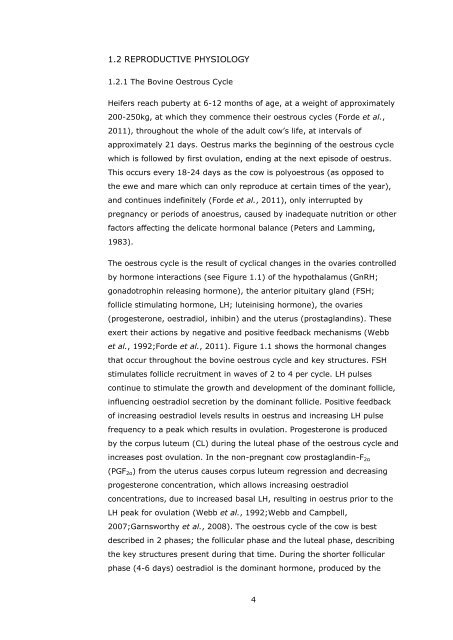novel approaches to expression and detection of oestrus in dairy cows
novel approaches to expression and detection of oestrus in dairy cows
novel approaches to expression and detection of oestrus in dairy cows
Create successful ePaper yourself
Turn your PDF publications into a flip-book with our unique Google optimized e-Paper software.
1.2 REPRODUCTIVE PHYSIOLOGY<br />
1.2.1 The Bov<strong>in</strong>e Oestrous Cycle<br />
Heifers reach puberty at 6-12 months <strong>of</strong> age, at a weight <strong>of</strong> approximately<br />
200-250kg, at which they commence their oestrous cycles (Forde et al.,<br />
2011), throughout the whole <strong>of</strong> the adult cow’s life, at <strong>in</strong>tervals <strong>of</strong><br />
approximately 21 days. Oestrus marks the beg<strong>in</strong>n<strong>in</strong>g <strong>of</strong> the oestrous cycle<br />
which is followed by first ovulation, end<strong>in</strong>g at the next episode <strong>of</strong> <strong>oestrus</strong>.<br />
This occurs every 18-24 days as the cow is polyoestrous (as opposed <strong>to</strong><br />
the ewe <strong>and</strong> mare which can only reproduce at certa<strong>in</strong> times <strong>of</strong> the year),<br />
<strong>and</strong> cont<strong>in</strong>ues <strong>in</strong>def<strong>in</strong>itely (Forde et al., 2011), only <strong>in</strong>terrupted by<br />
pregnancy or periods <strong>of</strong> an<strong>oestrus</strong>, caused by <strong>in</strong>adequate nutrition or other<br />
fac<strong>to</strong>rs affect<strong>in</strong>g the delicate hormonal balance (Peters <strong>and</strong> Lamm<strong>in</strong>g,<br />
1983).<br />
The oestrous cycle is the result <strong>of</strong> cyclical changes <strong>in</strong> the ovaries controlled<br />
by hormone <strong>in</strong>teractions (see Figure 1.1) <strong>of</strong> the hypothalamus (GnRH;<br />
gonadotroph<strong>in</strong> releas<strong>in</strong>g hormone), the anterior pituitary gl<strong>and</strong> (FSH;<br />
follicle stimulat<strong>in</strong>g hormone, LH; lute<strong>in</strong>is<strong>in</strong>g hormone), the ovaries<br />
(progesterone, oestradiol, <strong>in</strong>hib<strong>in</strong>) <strong>and</strong> the uterus (prostagl<strong>and</strong><strong>in</strong>s). These<br />
exert their actions by negative <strong>and</strong> positive feedback mechanisms (Webb<br />
et al., 1992;Forde et al., 2011). Figure 1.1 shows the hormonal changes<br />
that occur throughout the bov<strong>in</strong>e oestrous cycle <strong>and</strong> key structures. FSH<br />
stimulates follicle recruitment <strong>in</strong> waves <strong>of</strong> 2 <strong>to</strong> 4 per cycle. LH pulses<br />
cont<strong>in</strong>ue <strong>to</strong> stimulate the growth <strong>and</strong> development <strong>of</strong> the dom<strong>in</strong>ant follicle,<br />
<strong>in</strong>fluenc<strong>in</strong>g oestradiol secretion by the dom<strong>in</strong>ant follicle. Positive feedback<br />
<strong>of</strong> <strong>in</strong>creas<strong>in</strong>g oestradiol levels results <strong>in</strong> <strong>oestrus</strong> <strong>and</strong> <strong>in</strong>creas<strong>in</strong>g LH pulse<br />
frequency <strong>to</strong> a peak which results <strong>in</strong> ovulation. Progesterone is produced<br />
by the corpus luteum (CL) dur<strong>in</strong>g the luteal phase <strong>of</strong> the oestrous cycle <strong>and</strong><br />
<strong>in</strong>creases post ovulation. In the non-pregnant cow prostagl<strong>and</strong><strong>in</strong>-F 2α<br />
(PGF 2α ) from the uterus causes corpus luteum regression <strong>and</strong> decreas<strong>in</strong>g<br />
progesterone concentration, which allows <strong>in</strong>creas<strong>in</strong>g oestradiol<br />
concentrations, due <strong>to</strong> <strong>in</strong>creased basal LH, result<strong>in</strong>g <strong>in</strong> <strong>oestrus</strong> prior <strong>to</strong> the<br />
LH peak for ovulation (Webb et al., 1992;Webb <strong>and</strong> Campbell,<br />
2007;Garnsworthy et al., 2008). The oestrous cycle <strong>of</strong> the cow is best<br />
described <strong>in</strong> 2 phases; the follicular phase <strong>and</strong> the luteal phase, describ<strong>in</strong>g<br />
the key structures present dur<strong>in</strong>g that time. Dur<strong>in</strong>g the shorter follicular<br />
phase (4-6 days) oestradiol is the dom<strong>in</strong>ant hormone, produced by the<br />
4
















